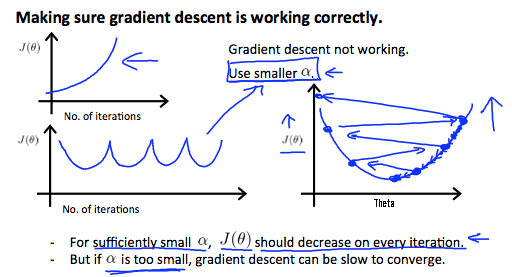Multivariate Linear Regression
Linear regression with multiple variables.
Notations
$$x^{(i)}_j$$ = value of feature
jin theith training example$$x^{(i)}$$ = input features of the
ith training example$$m$$ = number of training examples
$$n$$ = number of features
Hypothesis Equation
$$ \begin{aligned}
h_\theta(x) & = \theta_0 + \theta_1 x_1 + \theta_2 x_2 + ... + \theta_n x_n\ & = \begin{bmatrix} \theta_0 & \theta_1 & \dots & \theta_n \end{bmatrix} \begin{bmatrix} x_0\ x_1\ \vdots\ x_n \end{bmatrix}\ & = \theta^Tx
\end{aligned}
$$
Gradient Descent
$$ \begin{align} &\text{Repeat until convergence: {}\
&\hspace{1cm}\thetaj := \theta_j - \alpha\frac{1}{m} \sum^{m}{i=1}{(h_\theta(x^{(i)}) - y^{(i)}) \cdot x^{(i)}_j} \text{ for j := 0...n}\
&\text{}} \end{align}
$$

Gradient Descent in Practice
Feature Scaling
Prefer input variables to be in similar ranges.
Feature Scaling
Divide inputs by range (max - min) or standard deviation to fit then in range $$-1 \le x \le 1$$.
$$ x_i := \frac{x_i}{s_i} \text{ where s_i = range/standard deviation}
$$

Mean Normalization
Subtract average value from input variables to make features approximately zero mean.
$$ x_i := x_i - \mu_i
$$
Combination
$$ x_i := \frac{x_i - \mu_i}{s_i} \text{ where s_i = range/standard deviation}
$$
Learning Rate
Debugging Gradient Descent
Plot number of iterations to J(θ). See if cost function decreases correctly.
Automatic Convergence Test
Declare convergence if J(θ) decreases by less then a small value E e.g. $$10^{-3}$$ in one iteration.
* Fact: if learning rate α is sufficiently small, then J(θ) will decrease on every iteration.

- If
αtoo small: slow convergence - If
αtoo large: may not decrease on every iteration -> may not converge
Features and Polynomial Regression
Improving Features
Combining multiple features into one.
Polynomial Regression
Change the behavior or curve of h function by making it a quadratic, cubic or square root function (or any other form), to fit the data better.
$$ \begin{align}
h_{\theta}(x) &= \theta_0 + \theta_1x_1 + \theta_2x_1^2\ &= \theta_0 + \theta_1x_1 + \theta_2x_2
\end{align}
$$
* Ranges need to be taken care of for feature scaling.